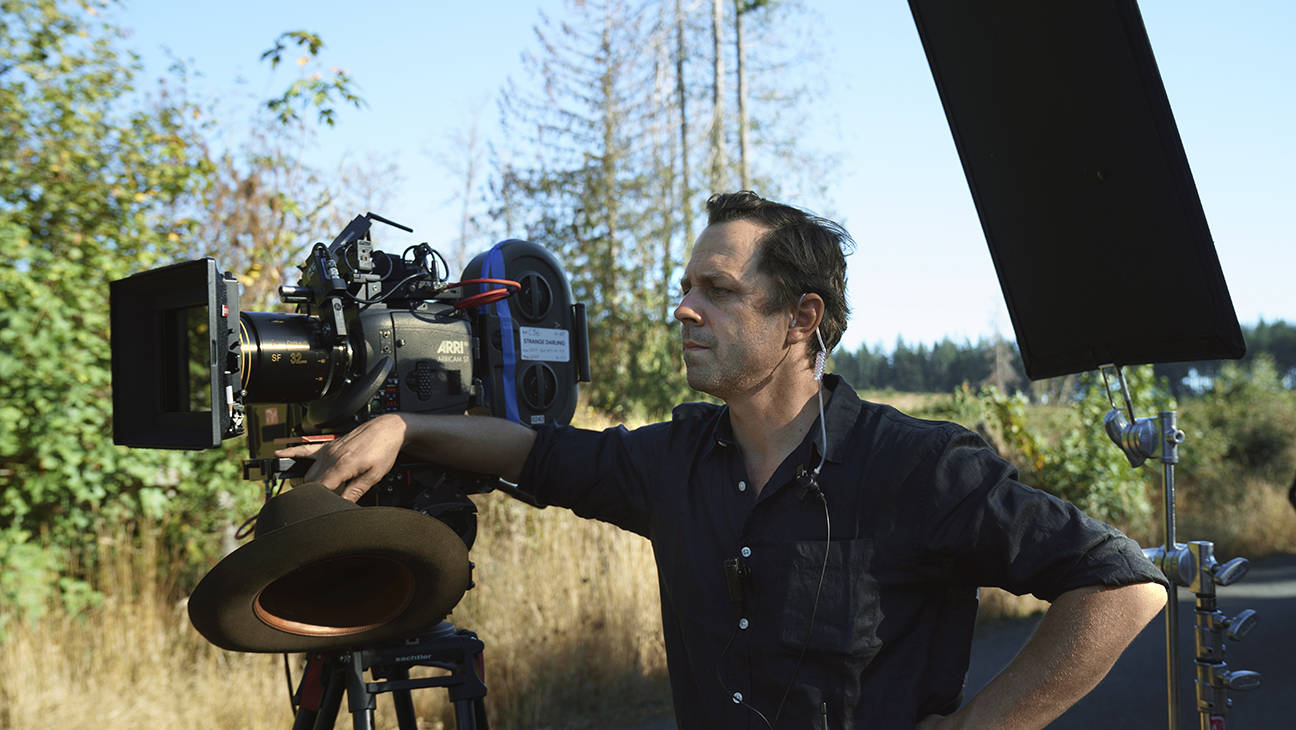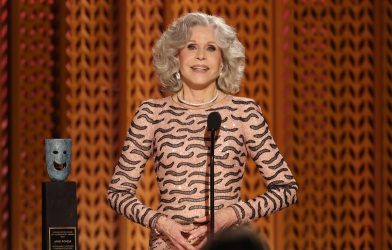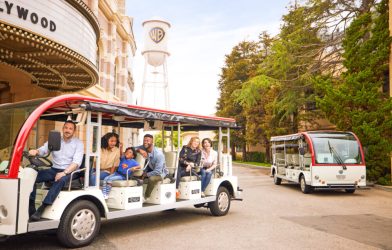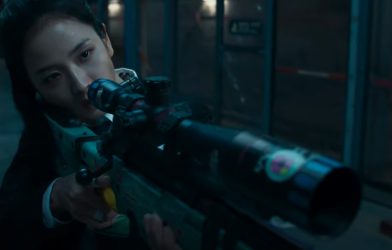Your eyes do not deceive you. Giovanni Ribisi — the same Giovanni Ribisi who boasts more than a hundred acting credits since 1985 — photographed and produced J.T. Mollner’s critically acclaimed thriller Strange Darling. The film’s nonlinear narrative is told through six chapters, and it explores the fallout of a calamitous one-night stand involving Kyle Gallner’s serial killer character, The Demon, and Willa Fitzgerald’s circumspect next target who’s credited as The Lady.
Throughout his four decades on film and TV sets, Ribisi has taken a keen interest in the work of his various directors of photography, and he credits a number of those DPs for sharing their know-how, beginning with Dante Spinotti, whom he worked with on Michael Mann’s Public Enemies (2009) and Garry Marshall’s The Other Sister (1999). The late Andrew Lesnie, who shot Peter Jackson’s The Lord of the Rings trilogy and won an Oscar for The Fellowship of the Ring, also set an example for Ribisi on the set of Love’s Brother (2004). He then goes on to credit Russell Carpenter after their work together on Avatar: The Way of Water and Avatar: Fire and Ash.
Over the past 15 years, Ribisi has turned his passion for photography into infrastructure that’s designed to make filmmaking more affordable and accessible. His studio, Stellascope, also prioritizes the use of celluloid, and upon meeting at a past ASC (American Society of Cinematographers) Awards, Ribisi and Mollner soon hit it off over their love of film stock. With experience photographing music videos and commercials, Ribisi then made it known that he wanted to lens a feature, and so Mollner started sending a few feature scripts his way until he lit up in response to one script known as One Night With You.
One Night With You eventually became Strange Darling, and once producers Roy Lee and Steve Schneider set up the project at Miramax, Mollner successfully made the case for Ribisi as DP. The result is a 96-minute thrill ride that’s shot exclusively on 35mm, and like a lot of champions of celluloid, Ribisi rejects the oft-used claim that it’s more costly than digital.
“There’s a lot of misconceptions about shooting film, and it is oftentimes not more expensive when you tally up the net expenditures on a film,” Ribisi tells The Hollywood Reporter. “It is not more expensive than digital because of all the other baggage that digital has.”
Ribisi’s acting career is still as vibrant as it’s ever been, and if his ongoing ties to James Cameron’s series of Avatar films weren’t enough, he’s now a key figure in Kevin Costner’s own multifilm ambition known as Horizon: An American Saga. Ribisi’s character, H. Silas Pickering, is expected to become a prominent villain in the third and fourth installments, and while Chapter 1 underwhelmed at the box office, Ribisi is more than confident that Costner will impose his will to complete his vision. Chapter 2, which premieres Sept. 7 at the Venice Film Festival, was already shot in close succession with Chapter 1.
“I have the utmost faith that when that man decides to do something, especially on this level, it’s going to get done and it’s going to be absolutely magnificent. I have an undying loyalty to him,” Ribisi says. “Look at how he has put his ass on the line. Look at what he has gambled. It’s phenomenal. Chapter 2 is going to the Venice Film Festival, and it’s well deserved. [The Horizon screenplays] are some of the greatest screenplays I’ve read. I am a huge fan of the Western, and I’m a huge fan of Kevin Costner. I always will be.”
Below, during a recent conversation with THR, Ribisi also breaks down some of the surprisingly challenging aspects of shooting Strange Darling.
When I first got the email about you and Strange Darling, DP was written in parentheses next to your name, and I assumed it was a typo. I had no idea that you had this skill set in your back pocket. During your downtime on movie sets, did you hang out in the camera and lighting department? Is that how this started?
I’ve definitely hung out with the camera departments on movies. For the last 40 years, it’s always been my fascination, and it’s something that I’ve been seriously working on for 15 years. So I finally decided to more or less come out of the closet with Strange Darling and J.T., because it was a story that I was just so drawn to. It was just something where the proverbial stars aligned.
Is there a particular DP from a past set who imparted the most wisdom on you?
Yeah, I would say most people because it was exactly what you implied. It was me bothering them. (Laughs.) But I would say Dante Spinotti, who I had the privilege of working with a long time ago [on Michael Mann’s Public Enemies]. Andrew Lesnie is no longer with us, but he was just an incredible cinematographer. He shot the Lord of the Rings movies and many others. And then, along the way, there was Russell Carpenter, Sal Totino [The Offer], Reed Morano [Meadowland]. The list goes on.

Giovanni Ribisi on the Set of Strange Darling.
Courtesy of Magenta Light Studios
So you shot a few music videos and commercials to get your feet wet, but how exactly did that turn into Strange Darling?
For 15 years, I’ve been building and investing in a small studio [Stellascope] that was essentially founded on the idea that movies are so bloated and expensive these days. At any point of entry, no matter what age you are, it becomes next to impossible. Making a movie and getting through to the finish line is a miracle, but on top of $200 million budgets, it just becomes this impossible dream.
So I built this shop, soup to nuts, with an infrastructure that’s centered around shooting celluloid, which was part of the equation in the conversation with J.T. It was, “Here’s what I can do as a cinematographer and what my knowledge base is,” but it’s deeper than just taking images or telling a story with a camera. I’ve worn every hat on a film set, and I know what my company is capable of doing and handling. And it just seemed that there was a way to make J.T.’s movie at a fraction of the normal cost of films and be successful with it.
The other thing that’s so important or relevant is that when you do have something that’s so incredibly expensive or bloated like the normal Hollywood budget system, it does affect creativity adversely. When you’re trying to be creative or solve problems creatively and you have this sense that you’re betting the farm and dealing with that kind of pressure, it affects the quality of the film. You start checking boxes off for a certain criteria that’s probably more about marketing or being commercial than making a film that’s effective and creatively moving for an audience.

Giovanni Ribisi and J.T. Mollner on the set of Strange Darling.
Courtesy of Magenta Light Studios
I hear stories all the time from filmmakers who have to put up a fight to shoot on film at the major studio level, not to mention the independent space.
J.T. and I bonded over the importance of shooting film, not just for the final image and its superior quality, but also the process that differentiates itself from shooting a film on digital. It just tends to be a more focused group of people who are cognizant of the fact that when the camera is rolling, money is being spent. That’s sort of the tried, clichéd argument [against it] now. There’s a lot of misconceptions about shooting film, and it is oftentimes not more expensive when you tally up the net expenditures on a film. It is not more expensive than digital because of all the other baggage that digital has. So, at some point, the actual budget of this movie will be published, and I think people will be really surprised.
The marketing campaign is the master stroke on top of it all. It adds to Strange Darling’s viewing experience and makes it all the more rewarding. Usually, trailers deduct from the actual experience because you’re shown too much of the film’s layout.
It might be sacrilege for me to say this, but I truly believe that the marketing for a movie is an audience’s first experience of the film and of the story. You are essentially giving them expectations before they actually experience the film, and it is so massively important. Most of the filmmakers that I’ve talked to and who I respect feel the same way. I’m talking more from a creative standpoint than a “butts in seats” standpoint; they’re two different topics. But, from a creative perspective, it’s great when everything comes together in this way, and the team at Magenta Light Studios and the people that I’m working with over at ID PR are phenomenal. They have exceeded any sort of expectations that we might’ve had.
The film is structured in six nonlinear chapters, and it begins with chapter three’s car chase. Did that test you a great deal in your feature debut as DP?
Well, I’ve done quite a few commercials with car sequences, and the folks over at Filmotechnic have what they call a Ucrane, which is this vehicle with an arm that’s mounted on top. It can go up to 25 feet, and it swivels 360 degrees with a stabilized camera hothead on the end of it. You can literally do anything with this, and you can get so much done within the allotted time frame. So we were able to squeeze that into the budget, and it was huge for that sequence. So I would say that the car chase was relatively some of the easier stuff that we encountered.
I don’t know if this is necessarily what they teach in film school, because I didn’t go to film school, but you spend months and months and months talking about that action sequence and storyboarding it and shotlisting it. You then have all of the various companies travel to you from all over the world, and the organization of all of that is just incredible. And then the orange Pinto that you have only drives 35 miles an hour. (Laughs.) So that was just one of the hundred myriad things that would come up on the day, and then you would have to deal with it and make it all work. At the end of the day, we laugh at those things, but while they’re all happening, you’re weeping silently to yourself.
On the opposite end of the spectrum, the motel room chapters’ dynamics are so complicated and constantly changing. Were those sequences as difficult to capture as anything else in the film?
That was another interesting thing. A location had fallen out the week before we were meant to be shooting there, and to make a long story short, the production designer, Priscilla Elliott, had 18 hours on a Sunday to prep that motel room. And the importance of knowing where you’re going to shoot is massive, from the photography and blocking to the set design. I know filmmakers who are working on soundstages right now, and they are in preproduction for a film that’s going to be shooting in November or December. You have months and months to talk about things: where you are going to put the camera, how high the ceilings need to be and how much light you need to get the feel you want for the movie. But we had 18 hours. (Laughs.) That’s one of the reasons why our crew was just phenomenal. We went in there, and we were able to snug lights up, but we still had to make compromises with certain things. J.T. and I had talked about shooting that sequence in a certain way, but at the end of the day, we’re both so proud of where it landed. That’s what was meant to be.

Kyle Gallner as The Demon and Willa Fitzgerald as The Lady in Strange Darling.
Courtesy of Magenta Light Studios
You have a voice cameo, but I have to imagine that you could have appeared in some capacity if you really wanted to do so. What kept you behind the camera?
It was just because we had exactly what this film needed in Kyle Gallner and Willa Fitzgerald. People have directed and acted in a movie a million times, but shooting is a rare thing. I think Michael Chapman played the cab driver in [The Last Detail], and he also shot the movie. But I also like to operate, so it would’ve been difficult.
In addition to J.T.’s dad, Duke Mollner, you could’ve been the other neighboring guest at the motel.
(Laughs.) Excuse me, do you guys have any ice?
Between Avatar and Horizon: An American Saga, you seem to be a magnet for multifilm sagas.
(Laughs.)
There’s now a saying in town to never bet against James Cameron. Should people start saying that about Kevin Costner? Do you think he’ll find a way to complete his vision?
I have the utmost faith that when that man decides to do something, especially on this level, it’s going to get done and it’s going to be absolutely magnificent. I have an undying loyalty to him. Look at how he has put his ass on the line. Look at what he has gambled. It’s phenomenal. Chapter 2 is going to the Venice Film Festival, and it’s well deserved. [The Horizon screenplays] are some of the greatest screenplays I’ve read. I am a huge fan of the Western, and I’m a huge fan of Kevin Costner. I always will be.
It’s pretty poetic that the beginning of your feature career also has another three-hour Costner epic in The Postman. I love career bookends like that.
(Laughs.) Yeah, that was a long time ago, my God.
There was some sad news in the Avatar family recently as producer Jon Landau passed away. He was a big part of the reason why people no longer bet against James Cameron. Have any particular memories sprung to mind of late?
There’s so many. He was such a positive influence on everybody he dealt with. He has such a beautiful family, and the film industry has lost one of the greats. I know that everybody on Avatar feels that way, and so it’s hard because there are no words for it.
You were a part of The Offer, which explored the making of The Godfather. If you could give the Offer treatment to one of your past projects, which one would make for the most compelling story?
Oh my God, there have been so many experiences. When I was coming up as an actor in the ‘90s, there was generally a different approach or mentality or outlook on making movies. I guess I miss the sacrifice and the absolute focus on trying to challenge yourself with a film or with the nature of film. It was truly blood, sweat and tears, and so there were all kinds of incredible things. For Saving Private Ryan, me and seven other castmembers went through a boot camp experience that DreamWorks or Amblin wanted us to do. It was their idea, and it was one of the most incredible experiences I’ve ever had with a [military adviser] called Captain Dale Dye. And what I learned from that two-week experience has stayed with me to this day, just as far as what I’m personally capable of and what the will can do for a human being. So it was just incredible, and I don’t even know if it would be legal now to do a boot camp. (Laughs.) He wouldn’t have put up with people having cellphones in boot camp, and maybe that’s the reason why.
When I was in college, there were certain films that were practically in the water. You’d walk around campus, and you’d often overhear the same DVDs being played in people’s dorm rooms. Well, Boiler Room was definitely one of those movies. It was watched and quoted all the time, and maybe it was because we were all looking forward to entering the workforce and attempting to strike it rich. (Writer’s Note: My college roommate was so inspired by Giovanni’s character’s “underground” card game that he started his own out of our apartment-like dorm. He actually built a custom dual-sided tabletop where one side was a card table and the other was an ordinary coffee table as far as the resident advisers were concerned. His entire operation lasted less than 48 hours after a couple of people won big.)
Yeah, I stay in touch with [writer-director] Ben Younger. I want to see more movies from him and I know he has more movies. That was such an interesting time and moment. When I go to New York, that’s what so many people talk about if I’m approached on the street. They bring that up and it’s funny.
Boiler Room is what should get the Offer treatment.
(Laughs.) I’m sure it would be enthralling.
***
Strange Darling is now playing in movie theaters.









